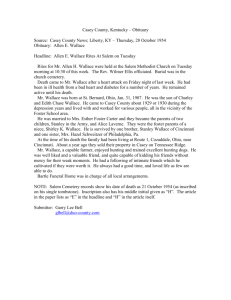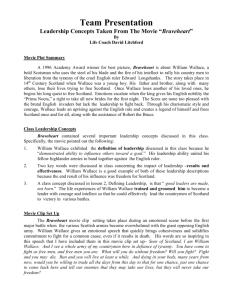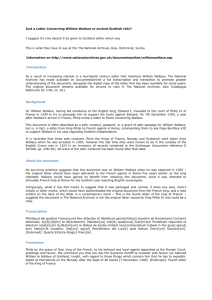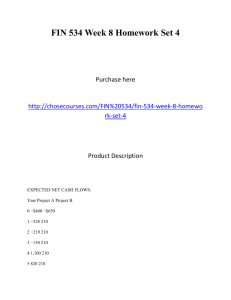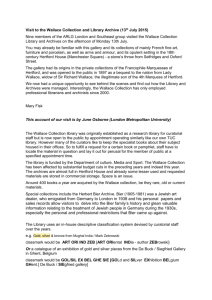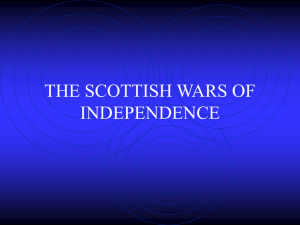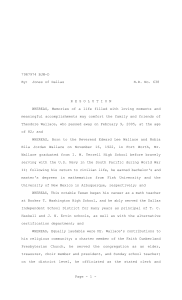William Wallace and Scottish resistance
advertisement
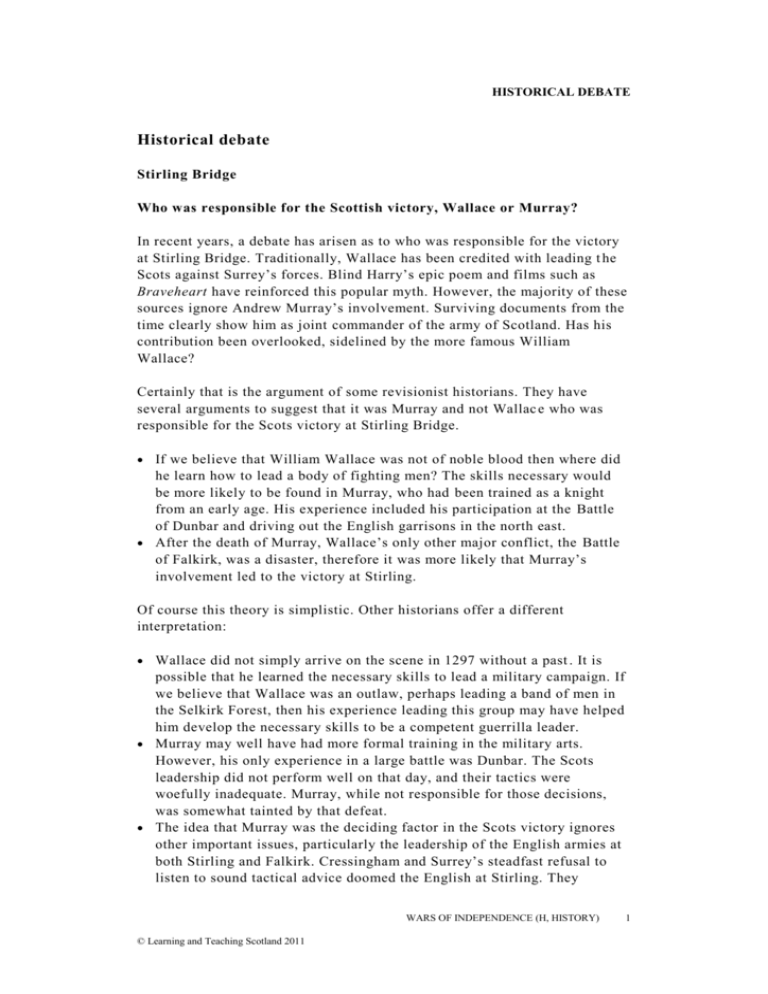
HISTORICAL DEBATE Historical debate Stirling Bridge Who was responsible for the Scottish victory, Wallace or Murray? In recent years, a debate has arisen as to who was responsible for the victory at Stirling Bridge. Traditionally, Wallace has been credited with leading t he Scots against Surrey’s forces. Blind Harry’s epic poem and films such as Braveheart have reinforced this popular myth. However, the majority of these sources ignore Andrew Murray’s involvement. Surviving documents from the time clearly show him as joint commander of the army of Scotland. Has his contribution been overlooked, sidelined by the more famous William Wallace? Certainly that is the argument of some revisionist historians. They have several arguments to suggest that it was Murray and not Wallac e who was responsible for the Scots victory at Stirling Bridge. If we believe that William Wallace was not of noble blood then where did he learn how to lead a body of fighting men? The skills necessary would be more likely to be found in Murray, who had been trained as a knight from an early age. His experience included his participation at the Battle of Dunbar and driving out the English garrisons in the north east. After the death of Murray, Wallace’s only other major conflict, the Battle of Falkirk, was a disaster, therefore it was more likely that Murray’s involvement led to the victory at Stirling. Of course this theory is simplistic. Other historians offer a different interpretation: Wallace did not simply arrive on the scene in 1297 without a past . It is possible that he learned the necessary skills to lead a military campaign. If we believe that Wallace was an outlaw, perhaps leading a band of men in the Selkirk Forest, then his experience leading this group may have helped him develop the necessary skills to be a competent guerrilla leader. Murray may well have had more formal training in the military arts. However, his only experience in a large battle was Dunbar. The Scots leadership did not perform well on that day, and their tactics were woefully inadequate. Murray, while not responsible for those decisions, was somewhat tainted by that defeat. The idea that Murray was the deciding factor in the Scots victory ignores other important issues, particularly the leadership of the English armies at both Stirling and Falkirk. Cressingham and Surrey’s steadfast refusal to listen to sound tactical advice doomed the English at Stirling. They WARS OF INDEPENDENCE (H, HISTORY) © Learning and Teaching Scotland 2011 1 HISTORICAL DEBATE revealed their intentions to the Scots not once but three times. It did not take a genius to work out how they would deploy in the future. Similarly, Wallace’s defeat at Falkirk was a more closely fought affair than is generally believed. It is true that Andrew Murray’s contributions at Stirling and before have generally been overlooked. However, it is not clear as to whether he was more responsible than William Wallace for the Scottish victory. Why did the nobles allow Wallace to rule as guardian? If William Wallace was the son of a minor knight or a common outlaw lurking in the forests of central Scotland, there is debate as to why the combined nobility of Scotland accepted him as the sole guardian after the death of Murray. This is especially important when the issue of the vacant throne of Scotland was still very much a problem. Certainly in the past the threat of civil war had been such a concern that the Community of the Realm had elected to follow a young girl rather than face a bitter power struggle. It may be the same here; the nobles were willing to follow Wallace rather than fight among themselves as to who would succeed King John. Of course, many of the Scottish nobles hoped for the return of King John. The fact that Wallace did not try to claim any authority for himself made it easier for the nobility to accept his rule. All of his announcements and let ters clearly show that he was ruling in the name of King John. It was from the legitimate authority of the kingdom that he claimed his power. Thus the illusion could be maintained, that the Scottish government continued as before. There is also a more practical suggestion as to why the nobles decided to allow Wallace to lead. They all had more to lose than he did. He could become a convenient scapegoat should the Scottish cause prove to be a failure. This idea that the nobles used Wallace because they were too afraid to stand up for themselves is not as popular as it once was. After the Battle of Falkirk and Wallace’s resignation, the nobles were not unwilling to take up the leadership of the cause. Both Robert Bruce and John Comyn became joint guardians and took the field against Edward. It seems unlikely that the noble community would have been less willing to do so after the victory of Stirling Bridge. That leads to what is often considered the least likely suggestion, that the nobles were both impressed and awed by what Wallace had accomplished. In Wallace they saw a warlord worthy of matching the ferocity of Edward I. Perhaps the simplest answer is the best: they allowed Wallace to become guardian because they believed he could deliver results. 2 WARS OF INDEPENDENCE (H, HISTORY) © Learning and Teaching Scotland 2011 HISTORICAL DEBATE What effect did Wallace’s execution have on Scotland? When compared to the treatment of the other Scots that had fought against Edward, Wallace’s fate at the hands of the English court was somewhat extreme. The harshness of both Wallace’s trial and his sentence has prompted some historians, such as Fiona Watson, to accuse the English king of being both rash and vindictive. However, what is important was the reaction to this violent execution by the Scottish population. It is often assumed that there was a great deal of unrest in Scotland at the method of Wallace’s execution and that his death was to inspire Robert Bruce five months later to begin his own rebellion and bid for the throne. However, this is not necessarily true. Bruce’s rebellion was sparked by the murder of Comyn, not a planned act, but a moment of madness. There is no real evidence that Bruce was ‘inspired’ by Wallace in any way. Indeed, Bruce was quick to accept Wallace’s betrayer, Menteith, into his fold. Menteith’s seal was attached to the Declaration of Arbroath, and he was seen as one of King Robert’s most loyal men. Nothing is known of contemporary reactions to Wallace’s execution. His body was quartered, and parts sent to Newcastle, Perth, Berwick and Stirling (or Aberdeen). At Newcastle we know that his remains were generally mocked, hung above the sewer entrance and jeered by the crowds. But in the Scottish burghs, there was no recorded reaction. No jeers greeted the body parts, but also there was no violent reaction seeking revenge for hi s death. It can be assumed that the execution was witnessed by a fair number of Scots. Many were in London for Edward’s parliament on the future considerations for the government of the kingdom. No one spoke up for Wallace at his trial, nor were there any records of a disturbance at his execution. In one respect this could be seen as telling judgment on Wallace by his contemporaries. He began and ended his short career as an outlaw, thus making it unlikely that the nobility of Scotland or the common folk would care about the manner of his ending. Not only that, but they were not in a strong position to speak up for Wallace when Edward was making decisions about the future of their lands. As with much of what we think we know about Wallace, his death and th e reaction to it has been influenced and altered by the myths that grew up around him in later generations. At the time of his death, the execution may have been extreme, but the component parts, such as the hanging and quartering, were everyday methods of punishing the crimes he had been found guilty of. From an English perspective, Wallace was found guilty of treason against his liege lord, so he suffered the punishment prescribed by law for WARS OF INDEPENDENCE (H, HISTORY) © Learning and Teaching Scotland 2011 3 HISTORICAL DEBATE this crime. His status as an outlaw was well known in Scotland and the punishment may not have seemed too out of place. Additionally, by 1305, Wallace may have been seen as something of an embarrassment by most Scottish nobles, as they had effectively capitulated to Edward. Edward was drawing up the Ordinance for Sc otland, a new set of rules to govern the kingdom. He had learned from his mistakes, and was now engaging actively with the Scottish nobles. Thus, it would appear that most Scots were willing to move on to a new phase of Anglo –Scottish relations. It is, therefore, with a certain mixture of hindsight and the growth of the myth surrounding Wallace that we see the reaction to his execution grow and take shape and develop. At the time, the reaction was a more muted acceptance of the inevitable guilty verdict of an outlaw. 4 WARS OF INDEPENDENCE (H, HISTORY) © Learning and Teaching Scotland 2011


